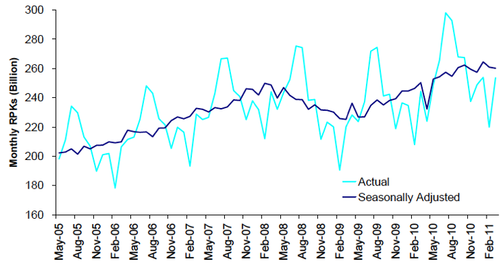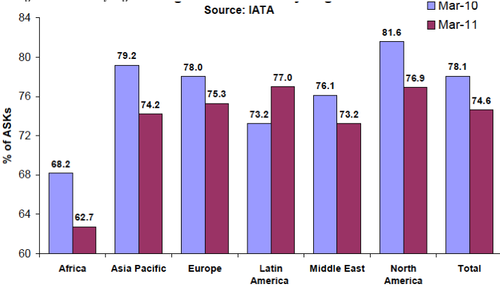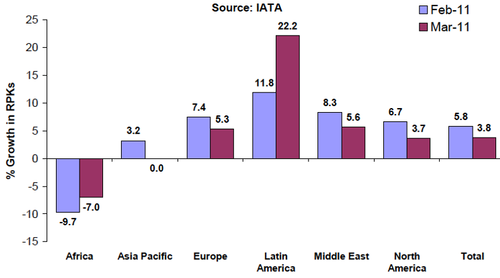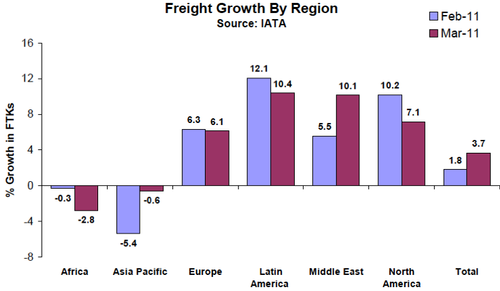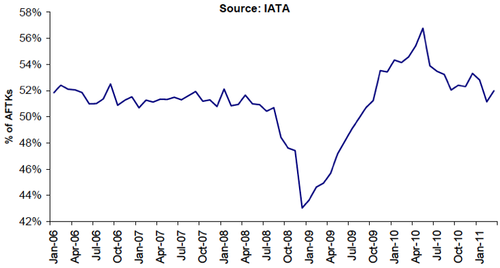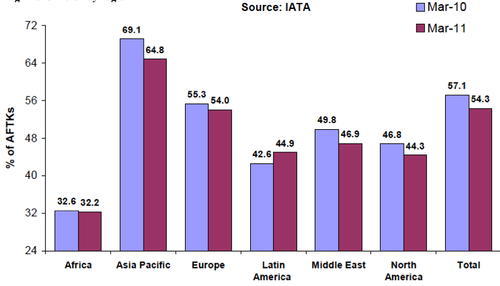Air travel growth slows in Mar-2011 with 2Q likely to remain depressed; 2H rebound likely: IATA
Growth in international air travel slowed in Mar-2011 as the Japanese earthquake and political turmoil in the Middle East and North Africa stalled the previously strong growth in air travel on international markets, IATA said. The Association warned that the second quarter would likely see "continued depressed air travel markets" due to these events.
Underlying upward movement and "robust" economic growth may spur a second-half rebound, though "the big uncertainty is the price of oil", which is hurting leisure travel in particular, IATA added.
These slowing growth rates represent a sharp deceleration in the growth of air transport demand from the situation in late 2009 and early 2010, when a post-recession rebound rate of around 10% was experienced. Last year international air travel volumes grew by 8.3% and international airfreight by 20.8%. Some slowdown this year was inevitable following the post-recession rebound in late-2009 and early 2010. However, until Feb-2011 air travel was growing close to its long-term trend of 6% a p/a. However, a number of events have significantly reduced air transport demand in the past two months. IATA estimates that international air travel worldwide was almost 2% points lower in Mar-2011 than it would have been in the absence of the events in Japan and MENA, ie international air travel growth would otherwise have been close to 6% a year.
Second consecutive month of weakened growth in Mar-2011
Air travel markets shrank for a second consecutive month in Mar-2011, hit by the situation in Japan, continued unrest in the Middle East and North Africa and high fuel prices, which have had a particularly evident impact on the more price-sensitive leisure market.
Scheduled international air travel (RPKs) rose 3.8% year-on-year in Mar-2011, slowing following growth of 5.8% in Feb-2011, with the 11-Mar-2011 Japan earthquake and tsunami and Mideast unrest each responsible for about half of the slippage, IATA said. The slowdown in traffic in Mar-2011 came as carriers expanded capacity by 8.6%, a combination that resulted in load factors slumping 3.5 ppts to 74.6%.
"The profile of the recovery in air transport sharply decelerated in March. The global industry lost 2 percentage points of demand as a result of the earthquake and tsunami in Japan and the political unrest in the Middle East and North Africa (MENA)," said Giovanni Bisignani, IATA's Director General and CEO.
IATA international passenger traffic: May-2005 to Mar-2011
Premium sees strong demand; leisure travellers weaker
On a positive note, IATA sees that there is "strong demand" from business for premium travel that maintained 7.7% growth through Feb-2011. After further travel disruption in the second quarter, the underlying economic strength boosting business travel and supporting consumer incomes and confidence should generate a second half recovery, IATA expects.
However, IATA noted that "many leisure travellers are putting off flying because of the impact of high oil prices. This has resulted in rising travel costs, dampening growth in price-sensitive travel. The fragility of the situation is demonstrated by the considerably weaker 3.3% year-on-year growth in economy class travel in Feb-2011."
Japan, Egypt and Tunisia witness massive declines in traffic
During Mar-2011, Japanese domestic travel slumped 22% between Feb-2011 and Mar-2011. In a full month, that represents a contraction of the domestic market in Japan by one-third. IATA estimates that the fall in air travel volumes on international markets connected to Japan caused a loss of more than 2% for Asia Pacific region airlines, more than 1% for North American airlines and 0.5% for European airlines. International air travel markets overall were reduced by an estimated 1% point in March due to the events in Japan.
Egypt and Tunisia experienced traffic levels as much as 25% below normal for March and military action in Libya stopped virtually all flights to, from and within the country, IATA said. The disruptions in MENA cut international travel by 0.9ppts. Egypt and Tunisia experienced traffic levels 10-25% below normal for March, according to IATA.
IATA traffic by region: Mar-2011 vs Mar-2010 and YTD2011 vs YTD2010
Month on month passenger declines
Compared with Feb-2011, global passenger demand fell by 0.3% in Mar-2011. Large declines in air travel due to the events in Japan and MENA, which cut traffic (RPKs) by 1.9%, affected Asia Pacific, North American and European airlines in order of their exposure, but were in large part offset by strong growth in Latin America and Africa.
IATA traffic comparison between Mar-2011 and Feb-2011
Passenger load factors declining
International capacity (ASKs) rose at an annualised rate of over 11% in the first quarter, while traffic volumes grew by only 3%, as a large Jan-2011 rise offset falls in Feb-2011 and Mar-2011. Load factors fell very sharply as a result.
Passenger load factor on international markets (seasonally adjusted)
The only exception was for airlines in Latin America, where traffic volumes continue to grow ahead of capacity. All other regions have seen a deterioration in seat utilisation and supply-demand conditions in their international markets. On average, seasonally adjusted load factors have fallen almost 4ppts from the record highs of mid-2010.
Passenger load factor by region
This load factor slump will have a direct negative effect on unit revenues in the first quarter. The loosening of supply-demand conditions that it represents will also make it more difficult for airlines to recoup higher fuel costs without damaging demand or without losing market share to competitors.
Regional difference evident
As usual, regional differences in passenger demand were evident in the month. Latin American airlines saw a very sharp improvement in markets in both Feb-2011 and Mar-2011. Meanwhile, African airlines saw a sharp reversal in growth, due to the political unrest in the region. Growth in other regions, such as Latin America, less affected by these disruptions, continued to show the strong upward momentum evident in emerging economies
Among the three large regions, air travel growth rates converged during 2010. In the immediate post-recession period Asia Pacific airlines benefited from exceptional growth, while Europe and North America lagged. Stronger international business travel in all regions led to all regions converging on growth rates of 6-8% towards the end of last year. Most recently Asia Pacific airlines have been hit most severely by the events in Japan, which are estimated to have cut growth by over 2ppts. The US economy has been doing better than expected, improving travel volumes, to the benefit of North American airlines. North American airlines saw their traffic cut by over 1% points by the weaker Japanese market. European airlines are suffering from weak home markets but international business travel is strong. These airlines saw a 0.5% loss from Japanese markets.
Passenger growth by region: Feb-2011 and Mar-2011
Cargo traffic growth accelerating
Air freight markets rebounded a little from depressed Feb-2011 levels in Mar-2011. International air freight volumes increased 3.7% year-on-year in Mar-2011, accelerating from growth of 1.8% in Feb-2011 when shipments from parts of Asia were limited by plant closures associated with the Chinese New Year. Compared with Feb-2011, cargo demand expanded by 4.5%, a figure which would have been higher if it were not for the Japan earthquake and tsunami.
International freight traffic: May-2005 to Mar-2011
Japan is a key supplier of parts in the electronics and auto supply chains, which are both key air freight customers. The disruption to the supply chains in these industries would have caused a significant loss to air freight volumes in Mar-2010. Supply chain disruptions from Japan are likely to continue through 2Q2011 before a second half rebound, according to IATA.
From the 2H2010 until Jan-2011, international air freight expanded in tandem with the growth in world trade at an annualized rate of about 10%. This was dented in Feb-2011 when growth, for a number of factors, fell to 1.8% over the same month in the previous year. The 3.7% year-on-year increase in Mar-2011 reflects more normal trading conditions (outside of Japan and MENA) during the month.
Freight growth by region
Freight load factors falling but at pre-recession levels
Meanwhile, freight load factors are down significantly from peaks earlier in 2010 but the decline has not been as precipitous as in passenger markets and the utilisation of freight capacity is still comparable with pre-recession levels. This may make it marginally easier for airlines to recoup higher fuel costs on air freight markets than is the case on passenger markets, according to IATA.
Freight load factor on international markets (seasonally adjusted)
The exception is again for Latin American airlines where, because of strong demand, they have managed to continue to improve their load factors.
Freight load factor by region
APPENDIX: International passenger demand by region
|
Carriers saw demand levels of 5.3% above Mar-2010. This was down from the 7.4% year-on-year growth in Feb-2011. Compared to Feb-2011 levels, Europe's carriers added 0.5% to capacity but experienced zero demand growth. This pushed load factors down by 0.3 ppts to 75.3%. Long-haul business travel is strong (except to Japan) but weak economic prospects continue to dampen intra-European traffic |
|
|
Carriers saw a 3.7% year-on-year improvement in demand in March. This was a 3 ppt tumble from the 6.7% growth recorded in Feb-2011. Compared to Feb-2011 levels, demand dropped 0.9% while capacity was up 0.3%. This led to a 0.9 ppt drop in load factors from Feb-2011 levels to 76.9%. |
|
|
Saw the broadest negative turn of fortunes in Mar-2011. Compared to the previous year passenger demand was flat. Compared to Feb-2011 however demand contracted by 2.2% while 0.8% was added to capacity. This led to a sharp 2.3ppt fall in load factors to 74.2% in Mar-2011 |
|
|
Experienced a 22.2% increase in demand compared to Mar-2011 levels that was severely depressed due to the earthquake in Chile. Compared to Feb-2011, demand was up by 4.7% while capacity expanded by 2.2%. Load factors improved 1.9ppts to 77% in Mar-2011-the highest among all regions. Latin American airlines saw a very sharp improvement in markets in both Feb-2011 and Mar-2011, with improvement in February and March. Last month's improvement was exaggerated by the comparison with March last year, when travel was depressed by an earthquake in Chile |
|
|
Saw year-on-year demand growth fall from 8.3% in Feb-2011 to 5.6% in Mar-2011. Compared to Feb-2011, demand was up by 0.1% while capacity expanded by 0.8%. This pushed the load factor down 0.6ppts to 73.2%. |
|
|
Saw demand fall 7.0% year-on-year. This is an improvement from the 9.7% drop recorded in Feb-2011. The region saw demand expand by 6.5% month-on-month against an increase in capacity of 6.2%. Load factors improved by 0.2ppts to 62.7%. This is sharply below the industry average of 74.6%. Egypt represents a significant portion of this region and the continuing disruption in March and in Tunisia was entirely responsible for the big deterioration in the traffic carried by these airlines. Flights in and out of Egypt and Tunisia were severely disrupted by the unrest in Feb-2011 and remained 10-25% below normal in Mar-2011 The military action in Libya caused commercial flights to virtually cease in Mar-2011. All together the MENA disruptions are estimated to have cut a further 0.9% points from international air travel. |
